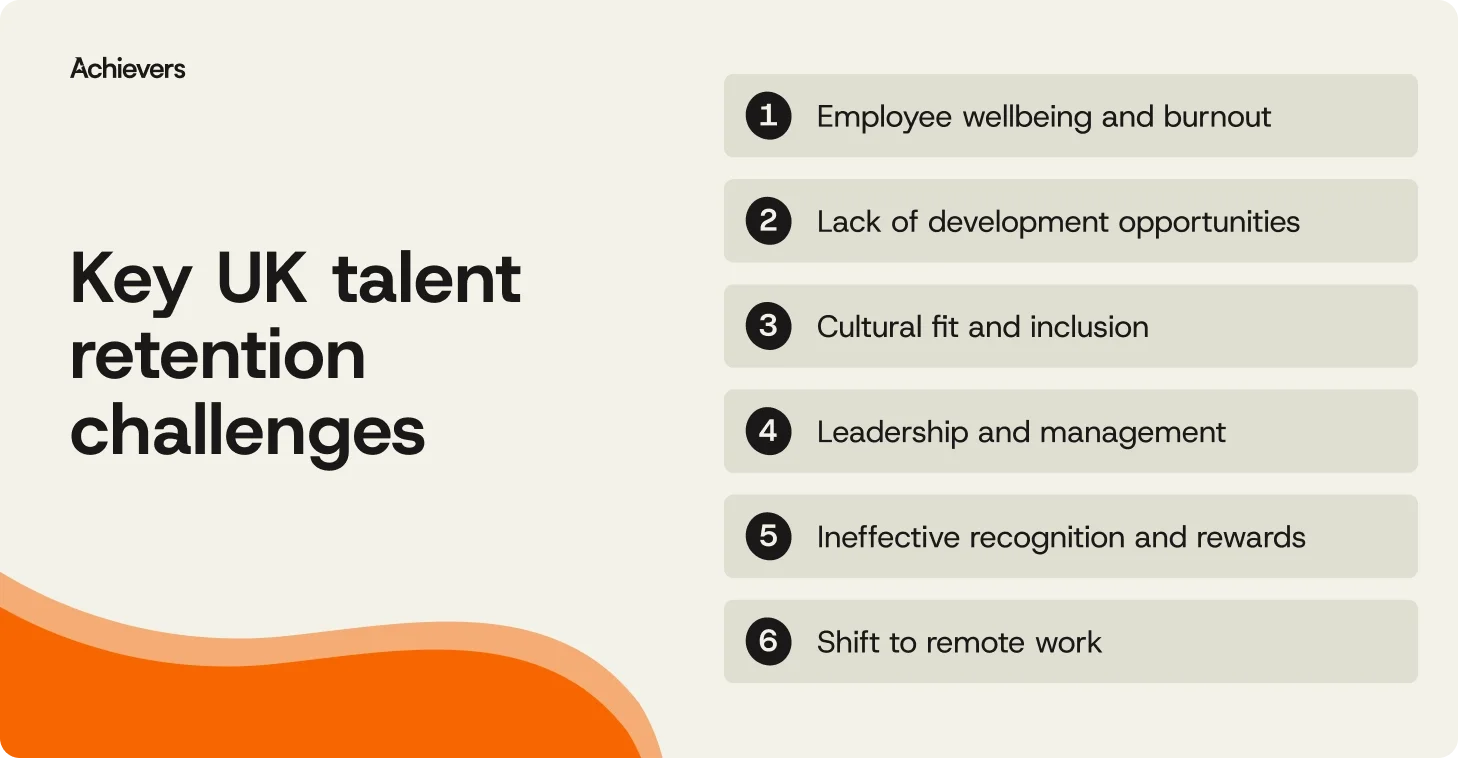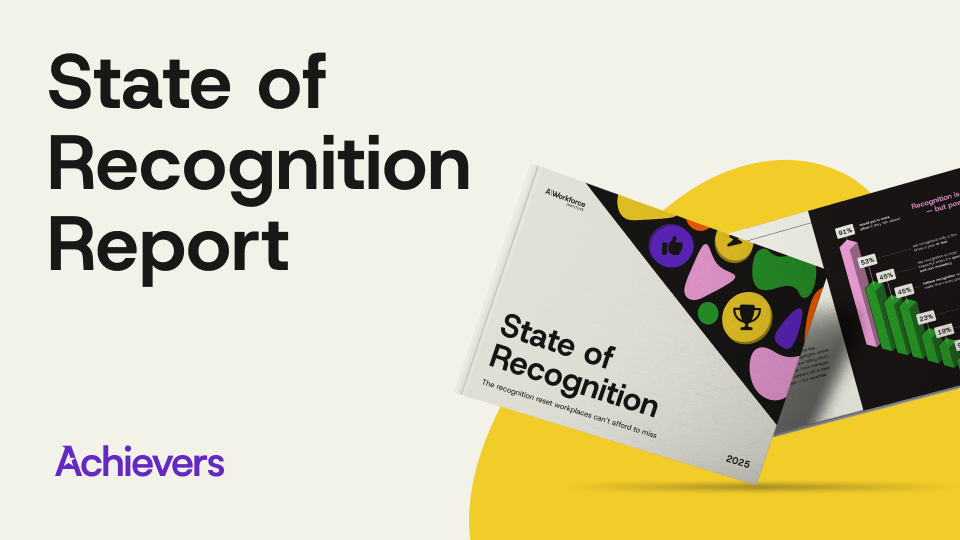Table of contents
UK talent retention challenges have never been more apparent or more nuanced. With 51% of HR professionals naming retention as their top concern, employers across the country are feeling the strain. And let’s be honest: it’s not just about saving on recruitment costs. When key talent walks, it leaves more than just an empty desk — it disrupts momentum, chips away at morale, and slows down business results.
So, what’s really going on? Why are so many employees eyeing the exit, and what can companies do to stop the churn before it starts?
In this blog, we’ll break down what’s fueling retention struggles across the UK, dig into the deeper issues behind the trends, and offer practical ways to keep your best people engaged and invested.
The current state of talent retention in the UK
Keeping talent isn’t just tough right now — it’s becoming one of the biggest challenges facing UK employers. Employees are asking more of their workplaces: better support, more purpose, and opportunities that actually lead somewhere. According to Ciphr, nearly 46% of UK employees aren’t convinced their company will deliver on work-life balance, pay, or wellbeing.
At the end of the day, the workplace is changing, and the way companies approach retention needs to change with it.
Market trends
According to the Achievers Workforce Institute (AWI), 43% of UK employees were undecided about job hunting in 2024. That kind of uncertainty doesn’t exactly scream stability.
Sectors like tech, healthcare, and retail are feeling the churn hardest. Turnover is making it tough to maintain momentum, especially when employee expectations are rising just as fast. Flexibility, purpose, and regular recognition aren’t seen as extras anymore — they’re the minimum price of admission.
The takeaway? If you want employees to stick around, you’ve got to give them a reason. And no, a ping pong table doesn’t count.
Economic and social factors
Sure, inflation and cost of living are stretching paychecks — but the fix isn’t just throwing more money at the problem. Employees want to feel like their needs are being seen, not just budgeted for. That means real flexibility, meaningful benefits, and a culture that values balance as much as output.
There’s also a generational shift at play. Younger workers are prioritising wellbeing, purpose, and impact — and they’re not afraid to walk if those things aren’t on offer. Legacy perks and vague promises aren’t cutting it. People want proof.
If your retention strategy feels like it’s stuck in 2015, chances are your employees won’t be.
Emerging skills gaps
The UK workforce isn’t just shifting — it’s shrinking in key areas. Roles in IT, healthcare, and engineering are especially tough to fill, thanks in part to a post-Brexit shortfall of around 330,000 workers. And when skilled talent is hard to find, holding on to the people you do have becomes even more important.
Upskilling and reskilling are essential moves, but they’re not the whole story. Employees want to feel like they’re building a future, not just filling a role. Recognition, support, and growth are your competitive edge.
6 UK talent retention challenges
With shifting employee expectations, economic pressures, and a rapidly changing professional landscape, understanding why employees leave has never been more important.
Here are six major UK talent retention challenges and what employers can do to address them:

1. Employee wellbeing and burnout
Stress and mental health concerns remain the leading reasons people walk away. According to Ciphr, 70% of employees can name at least one workplace factor that adds to their stress. Some sectors still lag in access to support, so pressure builds fast.
What to do: Make wellbeing part of the workflow, not a once‑a‑year campaign. Offer flexible work options, counselling access, and manager training on workload and boundaries. And recognise effort early and often. No one experiences workplace burnout from too many meaningful thank‑yous.
2. Lack of career development opportunities
Stagnant paths push people to look elsewhere. AWI research shows career progression is the top reason employees job hunt — and when internal opportunities are unclear or nonexistent, it’s easy for top talent to assume their next step has to be outside the company. Promoting from within doesn’t just close skills gaps; it signals that growth is possible here. That kind of visibility can be the difference between “I’m staying” and “I’ve started looking.”
What to do: Map skills, not just titles. Create visible paths, fund upskilling and mentoring, and celebrate growth milestones publicly. Recognition tied to development signals, “You’re going somewhere here.”
3. Cultural fit and inclusion
When values don’t match—or people don’t feel they belong—engagement drops and exits rise. Strong DEI efforts are linked to a 50% reduction in turnover risk, a 75% decrease in sick days, and a 167% lift in employer NPS.
What to do: Set clear DEIB goals, empower ERGs, and build everyday inclusion into manager habits. Measure belonging, not just attendance. Belonging beats beige swag every time.
4. Leadership and management
People don’t leave companies as often as they leave bad management. Employees want leaders who are clear, empathetic, and consistent.
What to do: Invest in manager enablement: coaching, active listening, and real‑time feedback skills. Give managers tools to recognise behaviours in the moment and close the loop on employee input. Poor management is expensive; good management compounds.
5. Ineffective recognition and rewards
Recognition gaps undermine loyalty. AWI’s State of Recognition Report shows 30% of employees recognised at least monthly rarely consider job hunting, compared to 13% recognised annually or less.
What to do: Drop the one‑size‑fits‑all approach. Make recognition frequent, specific, and tied to values; pair it with a rewards experience that feels personal and fair across locations. A once‑a‑year trophy doesn’t build a culture—daily moments do.
6. Shift to remote work
Distributed teams can lose the daily cues that keep people connected. Isolation grows; so does the temptation to look elsewhere—especially when remote‑friendly roles are everywhere.
What to do: Bring connection into the flow of work. Use tools that make recognition easy in Teams/Slack, set clear rituals for async and hybrid collaboration, and ensure remote employees get equal visibility for their contributions. Out of sight shouldn’t mean out of mind.
How to solve UK talent retention challenges
There’s no silver bullet for retention — but there is a smarter way to approach it. Between shifting employee expectations, rising competition for talent, and the very real pressure to do more with less, keeping great people takes more than good intentions. It takes a strategy that meets employees where they are and shows them why sticking around is worth it.
Here are a few ways to build a culture where people want to stay and thrive:
Start with the full employee experience
Every interaction — from the first interview to the last team meeting — shapes how employees feel about working at your company. And those impressions matter.
To build an experience that sticks:
- Use feedback tools to listen early and often — and show you’re acting on what you hear.
- Recognise people regularly, not just at year end. The small wins matter just as much as the big ones.
- Offer flexibility that works in real life — think hybrid schedules, wellness stipends, and ERGs that aren’t just window dressing.
- Make development feel accessible, not like a lottery win. That means career conversations, learning opportunities, and clear growth paths.
Boost career growth opportunities
Lack of progression is one of the top reasons people leave. And when employees can’t see a future with you, they start building one elsewhere. A lack of career progression is a major factor driving UK talent retention challenges, with 42% of HR pain points revolving around closing skills gaps.
To keep your top talent growing with you:
- Map out career paths that are transparent and accessible.
- Invest in upskilling and mentoring that supports both individual ambition and business needs.
- Build leadership pipelines — especially for underrepresented groups.
Modernise rewards and recognition programmes
Outdated recognition programs won’t cut it anymore. Employees want appreciation that’s real, personal, and timely — not just a logo-printed water bottle once a year. To drive retention, it’s time to modernise employee rewards and recognition.
Here’s what works:
- Use platforms that enable real-time, values-based recognition — especially in hybrid and remote teams.
- Personalise rewards to what employees actually want (our research shows that frequency and relevance matter more than flash).
- Make recognition a habit, not a checklist. Consistency builds culture.
Build a culture of belonging
Belonging isn’t just good for morale — it drives retention, performance, and engagement. But it doesn’t happen by accident.
To foster a more inclusive, values-aligned culture:
- Set and track measurable DEIB goals.
- Support employee resource groups and diverse hiring pipelines.
- Make sure your policies support equity across the full employee lifecycle.
Invest in leadership and management training
Most employees experience your culture through their manager. So if you want better retention, start with better leadership.
Help managers become the leaders employees want to work for:
- Train them on emotional intelligence, feedback, and coaching — not just task delegation.
- Give them tools to recognise their teams and respond to feedback.
- Make retention part of their performance goals.
Build a UK talent retention strategy that drives business results
Between rising burnout, shifting values, and economic pressure, UK talent retention has become a full-time job. But there’s a real opportunity to do things differently.
At Achievers, we help organisations shift from reactive fixes to recognition-led strategies that actually stick. When recognition is built into the way your company works — frequent, personal, and tied to what matters — you don’t just see happier teams. You see stronger engagement, more consistency, and better business outcomes.
Our customers are seeing the difference. They’re more than twice as likely to improve retention and twice as likely to see longer employee tenure. That’s the power of getting recognition right.




